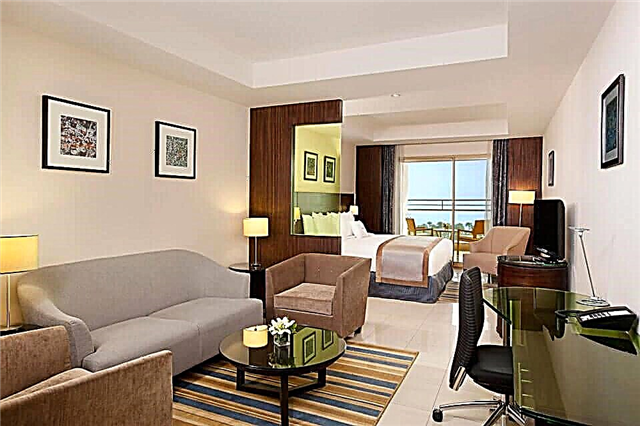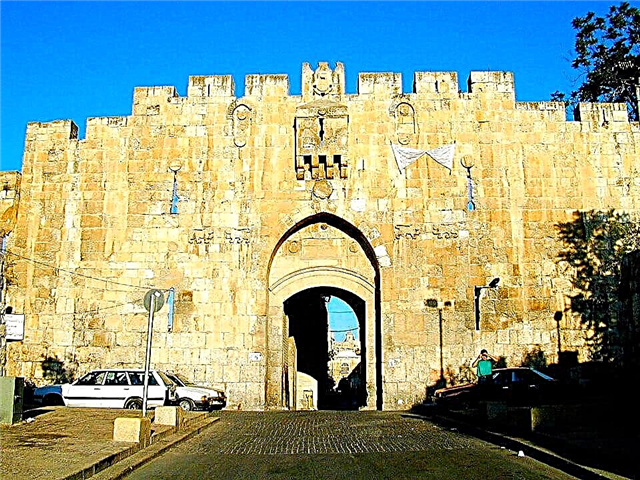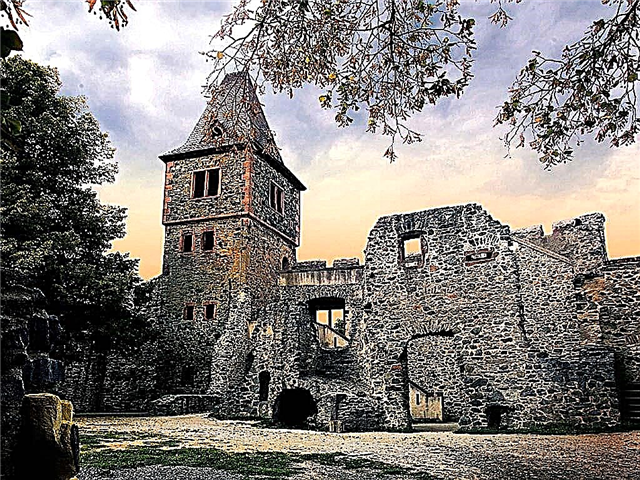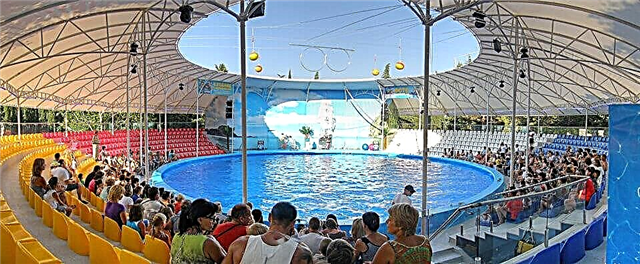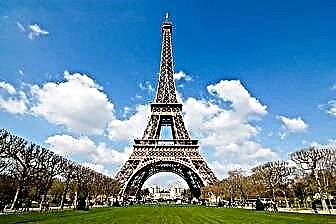Paris has always been covered with a romantic halo. This is one of the most beautiful cities in Europe, the capital of lovers, the center of art and palatial European architecture. Excursion programs in Paris are always rich, so every day you will discover the capital of France anew.
A river walk along the Seine, admiring the solemn vaults of Notre Dame de Paris, a picnic on the lawn in front of the Eiffel Tower, tasting the best French wines and cheeses - this is a small list of things to do during your trip to Paris.
All year round, festivals and events are held in the French capital, interesting theatrical premieres start, and the best exhibitions in Europe are organized. Paris is also a center for gastronomic tourism. Haute French cuisine is considered the finest in the world.

The best hotels and hotels at affordable prices.
from 500 rubles / day
What to see and where to go in Paris?
The most interesting and beautiful places for walking. Photos and a short description.
Eiffel Tower
The most famous and recognizable symbol of Paris (and all of France), a place of pilgrimage for tourists from all over the world. The attraction is visited by several million people annually. The tower is a metal structure 324 meters high with elevators, an observation deck, restaurants and a lighthouse at the top. It was built by Gustave Eiffel and originally served as the entrance to the 1900 Paris World's Fair.

Louvre Museum
The architectural ensemble that served as the residence of the French kings from the 16th to the 17th centuries. before the yard moved to Versailles. The palace turned into a museum already in the 18th century. The first collections were collected from the personal funds of Francis I and Louis XIV. Now the collection of the Louvre has more than 400 thousand exhibits, about 35 thousand are constantly exhibited. The museum contains the famous painting "Mona Lisa", created by da Vinci.

Triumphal Arch
An architectural monument at Charles de Gaulle square. The construction of the monument began in 1806 by order of Napoleon Bonaparte after the French victory in the Battle of Austerlitz. The work was completed after the death of the emperor in 1936. The arch was built by architect Jean Chalgren. On four sides, the monument is decorated with sculptural groups dedicated to the military victories and achievements of the French Revolution.

Notre dame cathedral
An outstanding example of Gothic architecture, the most visited cathedral in Paris. It began to be erected in the XII century on the site of the ancient pagan temple of Jupiter. By the middle of the XIV century, the work was completed. During the French Revolution, Notre Dame fell into decay, but in 1804 Napoleon Bonaparte chose it as the site of his coronation, which partially returned the temple to its former significance. The last restoration was carried out in the 1920s.

Basilica of the Sacre Coeur
The temple is located on the Montmartre hill, it towers over Paris with snow-white domes. Construction began in the second half of the 19th century, when France was going through hard times. The temple was erected on the site of a demolished Benedictine monastery, where Ignatius Loyola himself, the future Grand Master of the Jesuit order, took vows. The basilica was built for over 30 years with donations from Parisians and public funds.

Champs Elysees
The famous Parisian street, along with Fifth Avenue in New York and Oxford Street in London, is considered the most expensive street in the world. It stretches for almost 2 km. from the Arc de Triomphe to the Place de la Concorde. Important events for the public life of France are held here; during the holidays, the street is elegantly decorated with garlands. On the Champs Elysees shops of famous brands, restaurants, hotels are concentrated.

Palace of Versailles
A palace and park ensemble in a Parisian suburb, the famous residence of the French monarchs. Versailles appeared thanks to the efforts of Louis XIV in the 17th century. Gradually, from a modest hunting castle under the supervision of architects Jules Hardouin-Mansart and Louis Leveaux, a luxurious palace grew, which became a symbol of the era of the "King of the Sun". Many European monarchs took Versailles as a model for the construction of their own residences.

Luxembourg Gardens and Palace
The architectural complex was erected for the wife of Henry IV, Marie de Medici in the 17th century. Now the French Senate sits in the palace, and the garden has become a popular place for walks among Parisians. Concerts and photo exhibitions are often held here. The attraction is located in the Latin Quarter of the city. Somewhere in this area, the famous characters of A. Dumas lived from the immortal work "The Three Musketeers".

Montmartre
The hill and the famous area of the French capital. A picturesque place where representatives of the Parisian bohemia lived, among whom were Andre Salmon, Picasso, Modigliani, Georges Braque. The modern artistic style of Cubism was born in Montmartre. A considerable number of attractions are concentrated here: boulevards, temples, museums. Art people still gather in the main square of the district.

Isle of Cité
Located in the very center of the capital, in the middle of the Seine River. Several bridges connect the island to the rest of the city on all sides. Cité is the very heart of Paris, home to Notre Dame de Paris, the Conciergerie Castle and the Sainte Chapelle Chapel. Celtic settlements on the island appeared in 300 BC. In 508 A.D. the Cité fortress became the seat of rulers from the Merovingian clan, the first dynasty of French rulers.

Bastille square
A late 18th century square built on the site of the defensive fortress of the Bastille. For almost 400 years, the fort served as a prison for political prisoners and became a symbol of the hated monarchy for the people. After the famous storming of the Bastille on July 14, 1789, it was decided to dismantle the building. A wide area was paved in its place. In 1840, the July Column was erected here in honor of the July Revolution.

Latin quarter
An ancient area in the center of Paris, located around the Sorbonne University. Previously, it was mainly students who settled here, since in addition to the Sorbonne, there are several other educational institutions in the quarter. Over time, the area has developed into a tourist attraction. It is always noisy and fun here. The many bars provide a casual party atmosphere.

Sorbonne
The real pride of France, one of the best and oldest European universities. The educational institution was founded at the beginning of the XIII century and since then it has been sacred to the old traditions and maintains the highest quality of education. Since the beginning of the 17th century, the Sorbonne has become the center of European philosophy and theology. Today the Sorbonne brand unites 13 independent universities.

Georges Pompidou Center
Popular Museum of Contemporary Art, built in 1977 by French President J. Pompidou. It is a symbol of modernization and renewal of France. The original design of the building was proposed by the authors R. Rogers and R. Piano. The construction is unusual in that all engineering communications are taken out, and inside the maximum space is used for various expositions.

Orsay Museum
A museum displaying collections of the Impressionists and Post-Impressionists. The building was under construction for the opening of the 1900 Paris World Exhibition and was used as a railway station until 1939. The architecture of the museum is a combination of elements of the industrial style with the classicism of the 19th century. After the station was closed, it was planned to demolish the house and build a hotel in its place, but then it was decided to organize a museum.

Opera Garnier
Another name for the theater stage is the Grand Opera. Its construction began during the reign of Emperor Napoleon III in the middle of the 19th century according to the project of the architect Charles Garnier.Several dozen sculptors worked on the decoration of the facade, so there is no single style in the design. The interiors of the opera are made without bulky columns and props (like in other theaters), so there is a lot of space and light inside.

Moulin Rouge cabaret
The famous French variety show, art café and the hallmark of Parisian nightlife. Cabaret has existed since the end of the 19th century and has been very popular for over 100 years. At first, this place was considered a "lousy place" with frivolous morals. The cabaret room is always full, tickets for shows are sold out in advance. The show features dozens of artists and hundreds of costumes made by renowned designers.

House of Invalides
An architectural complex near the Eiffel Tower. The house was erected under Louis XIV and was used as a shelter for veterans who were injured and maimed during the wars. There were no such institutions in Europe, so the monarch showed himself from the best side, showing concern for his subjects. The Invalides received its first guests in 1674. The ensemble consists of the Church of St. Louis, orderly rows of barracks, a park and a hospital.

Conciergerie
Former royal castle on the Ile de la Cité, one of the oldest in Paris. It was built on the site of a 6th century fortress where the Frankish king Clovis lived. Until the end of the 14th century, French monarchs lived in the castle, but after the court moved to the Louvre, the Conciergerie was turned into a prison, which over the centuries was overgrown with dark stories. From here, thousands of prisoners went to the guillotine (including Queen Marie Antoinette).

Pantheon
Building in the style of French classicism in the Latin Quarter. Initially it served as a church, but later turned into a burial place of famous and important personalities in French history. The construction of the Pantheon began in 1764, the first stone was laid by King Louis XV. The ashes of the great thinkers Rousseau and Voltaire, the writers Emile Zola and Victor Hugo, the physicist Maria Sklodowska-Curie lie under the arches of the building.

Montparnasse tower
The only skyscraper in the city limits more than 200 meters high. The tower houses offices of companies, shops, banks and restaurants. More than 5,000 employees are housed in the building every day. You can get to the observation decks if you use high-speed elevators that lift passengers to the 56th floor in a few tens of seconds. The tower was erected in the period 1969-1972.

Pere Lachaise cemetery
The world-famous necropolis, where many famous personalities are buried. The attraction attracts over 2 million tourists a year. The cemetery has been operating since 1804, over two centuries its territory has grown to several dozen hectares, today it is a whole city with alleys, chapels and monumental crypts. Many actors, statesmen, writers, painters and poets have found their final resting place here.

Catacombs of paris
A network of artificial caves and tunnels laid at a depth of 15-20 meters. Their total length is more than one hundred kilometers. The dungeons have existed since the 13th century. Previously, there were limestone mines, then wine cellars, and since the 18th century - underground cemeteries. Tourists can follow the 2.5 - kilometer excursion route in the catacombs, the rest of the underground complex is closed.

Alexander III bridge
A graceful bridge, decorated with figures of angels, nymphs and tracery lanterns in the architectural style of Beaux-Arts. Thrown across the river Seine. After crossing the bridge, you can get from the Champs Elysees to the territory of the Invalides. The structure was named after the Russian Emperor Alexander III to emphasize the closeness of France and Russia at a certain period of time. The bridge was declared a valuable architectural monument in 1975.

Boulevard Capuchinok
Parisian street, which gained fame during the development of cinema. It was here in 1985 that the Lumière brothers showed their first film. After that, small cinemas began to open one by one on the boulevard, as the new art quickly gained popularity among the public. The Olympia and Paramount Opera, opened at the beginning of the 20th century, are still operating. Composer Jacques Offenbach lived on Boulevard des Capucines.

Bois de Boulogne
A large green massif of Paris, a park area that is called the "western lungs of Europe". In past centuries, the royal hunting grounds were located here. On the territory of the forest, luxurious parties, receptions, and outdoor picnics of the French court were held. Under Louis XVI, the Bois de Boulogne was opened to the public. Now this area has become a popular city park.

Tuileries Garden
A public park that stretches from the Louvre to the Place de la Concorde. In the garden there are sculptures - copies of exhibits from the royal Versailles, chestnut alleys are planted, flower beds are laid out. The park was founded by Catherine de Medici. By her order, the tile workshops were demolished (they were called "tuileries", hence the name of the garden) and the place was cleared for a future park.

Seine river
The river, which is considered the soul and center of life in Paris. It is one of the largest in France. The Seine originates in Burgundy and flows into the English Channel. On the territory of Paris, the river artery bends many times, dividing the French capital into a historical, cultural and business part. Numerous pleasure boats ply along the Seine, transporting tourists from area to area.

Galeries Lafayette
A shopping mall, a temple of the fashion industry and a pilgrimage site for fashionistas from all over the world. Collections of all renowned French designers are presented here. Initially, at the end of the 19th century, it was a small shop selling ribbons and lace, but after a few years it grew into a large shopping center. Galeries Lafayette was one of the first to apply modern marketing: bright signs, discounts and large showcases.

Disneyland
An amusement park in the Parisian suburb of Marne-la-Valais, has been operating since 1992. The park is owned by the American company Walt Disney. This is a magical world for children, where all the famous characters of "Disney" cartoons live, scenery from favorite fairy tales has been recreated, and countless attractions also work, delighting adults. The park is home to residential and business districts, hotels and golf courses.






